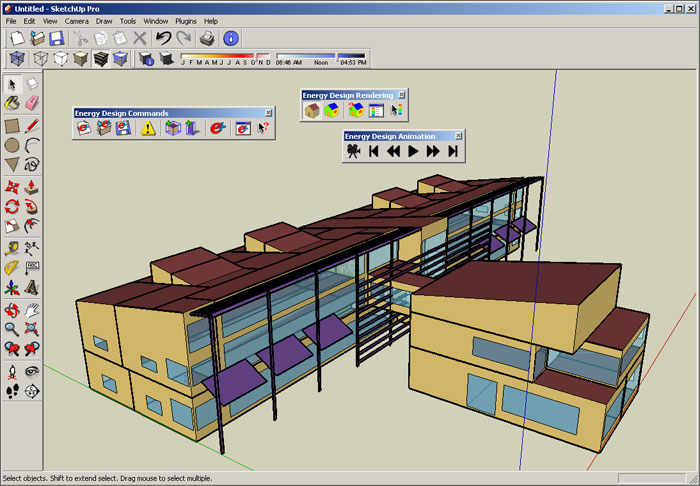This article is part of BD+C's special five-part Technology Report 2014: Top tech tools and trends for AEC professionals.
For more than a decade, the U.S. Department of Energy has made its EnergyPlus energy analysis and thermal load simulation program available for free to Building Teams.
Using EnergyPlus, AEC professionals can model heating, cooling, lighting, ventilation, and other energy flows, as well as water consumption, within a building design.
But without a major rewrite of the program since its creation, using EnergyPlus could exhibit slow performance and occasionally inaccurate analysis results.
The programming language it was originally written in, Fortran, simply could not keep up with advances in the hardware and software computing environment. FORTRAN is a language aimed at scientific programs to be run by scientists for days and weeks on supercomputers, not by building designers running multiple iterations of a design idea in a matter of a few hours.
Because it wasn't well integrated with common architectural design software, EnergyPlus never gained widespread adoption by architects working in the conceptual stage of a project.
At Greenbuild 2013, Autodesk (working pro bono) turned over brand new engine source code to the DOE to create a completely rewritten EnergyPlus for a forthcoming version. The new code will be made available under the DOE’s open source license.
Autodesk’s software engineers translated EnergyPlus—more than 600,000 lines of code—to C++, a modern, object-oriented language that is better supported on mass-market hardware and software platforms.
As a result, a larger ecosystem of developers and vendors will be able to contribute updates to the code in order to improve performance and decrease the time required to run energy model simulations.
The forthcoming version will also work better with BIM applications, auditing tools, and energy dashboards after it is released and developers are able to work on improved integrations.
For more, visit: http://apps1.eere.energy.gov/buildings/energyplus.
Related Stories
| Aug 11, 2010
Architecture Billings Index bounces back after substantial dip
Exhibiting a welcome rebound following a 5-point dip the month prior, the Architecture Billings Index (ABI) was up almost 6 points in July. As a leading economic indicator of construction activity, the ABI reflects the approximate nine to twelve month lag time between architecture billings and construction spending. The American Institute of Architects (AIA) reported the July ABI rating was 43.1, up noticeably from 37.7 the previous month.
| Aug 11, 2010
Rafael Vinoly-designed East Wing opens at Cleveland Museum of Art
Rafael Vinoly Architects has designed the new East Wing at the Cleveland Museum of Art (CMA), Ohio, which opened to the public on June 27, 2009. Its completion marks the opening of the first of three planned wings.
| Aug 11, 2010
National Association of Governors adopts AIA policy of reaching carbon neutrality in buildings by 2030
As part of their comprehensive national Energy Conservation and Improved Energy Efficiency policy, the National Association of Governors (NGA) has adopted the promotion of carbon neutral new and renovated buildings by 2030 as outlined by the American Institute of Architects (AIA).
| Aug 11, 2010
Installation work begins on Minnesota's largest green roof
Installation of the 2.5 acre green roof vegetation on the City-owned Target Center begins today. Over the course of two days a 165 ton crane will hoist five truckloads of plant material, which includes 900 rolls of pre-grown vegetated mats of sedum and native plants for installation on top of the arena's main roof.
| Aug 11, 2010
AASHE releases annual review of sustainability in higher education
The Association for the Advancement of Sustainability in Higher Education (AASHE) has announced the release of AASHE Digest 2008, which documents the continued rapid growth of campus sustainability in the U.S. and Canada. The 356-page report, available as a free download on the AASHE website, includes over 1,350 stories that appeared in the weekly AASHE Bulletin last year.
| Aug 11, 2010
AECOM, Arup, Gensler most active in commercial building design, according to BD+C's Giants 300 report
A ranking of the Top 100 Commercial Design Firms based on Building Design+Construction's 2009 Giants 300 survey. For more Giants 300 rankings, visit http://www.BDCnetwork.com/Giants
| Aug 11, 2010
AIA approves Sika Sarnafil’s continuing education courses offering sustainable design credits
Two continuing education courses offered by Sika Sarnafil have been approved by the American Institute of Architects (AIA) and are now certified to fulfill the AIA’s new Sustainable Design continuing education requirements.
| Aug 11, 2010
HNTB, Arup, Walter P Moore among SMPS National Marketing Communications Awards winners
The Society for Marketing Professional Services (SMPS) is pleased to announce the 2009 recipients of the 32nd Annual National Marketing Communications Awards (MCA). This annual competition is the longest-standing, most prestigious awards program recognizing excellence in marketing and communications by professional services firms in the design and building industry.
| Aug 11, 2010
'Flexible' building designed to physically respond to the environment
The ecoFLEX project, designed by a team from Shepley Bulfinch, has won a prestigious 2009 Unbuilt Architecture Design Award from the Boston Society of Architects. EcoFLEX features heat-sensitive assemblies composed of a series of bi-material strips. The assemblies’ form modulate with the temperature to create varying levels of shading and wind shielding, flexing when heated to block sunlight and contracting when cooled to allow breezes to pass through the screen.







